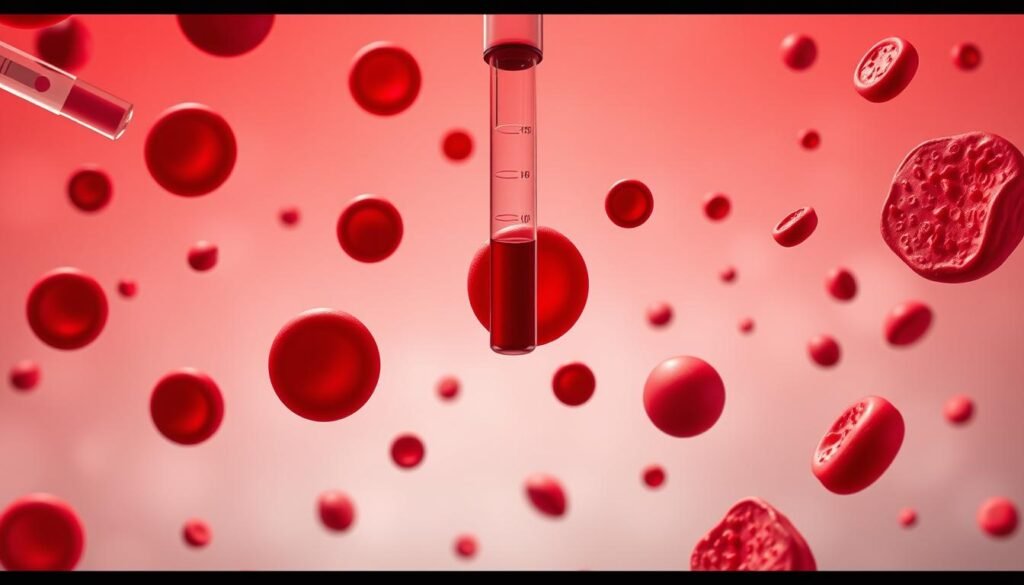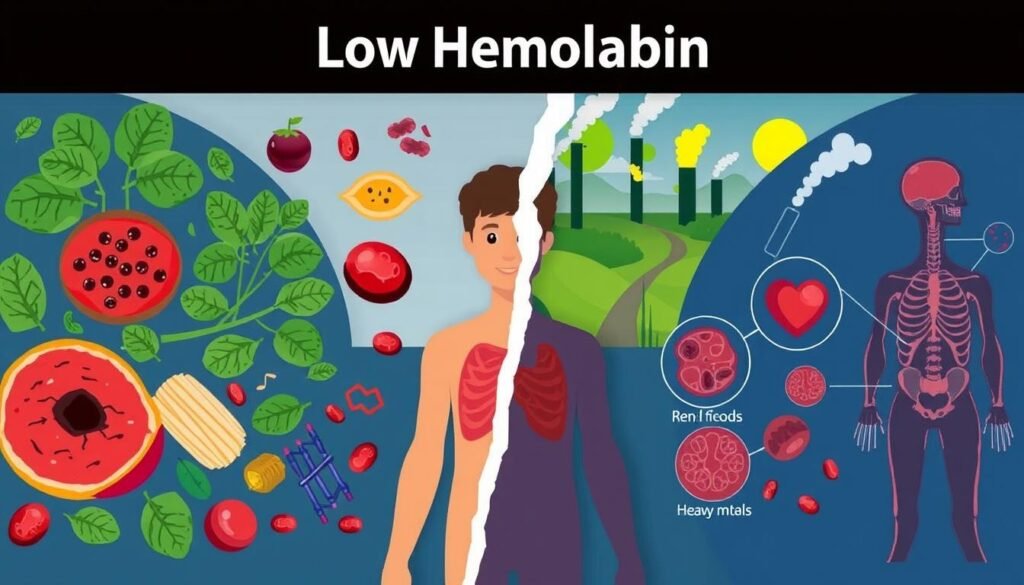Did you know that anemia impacts over 3 million Americans? It’s the top blood disorder in the United States. This condition, marked by not enough hemoglobin, can cause many health issues if ignored. Hemoglobin is a key protein in red blood cells that helps move oxygen everywhere in your body.
Keeping hemoglobin at a good level is key for feeling great. We will look into why hemoglobin gets low, what signs to watch for, how to find out if you have it, ways to treat it, and how to stop it from happening. This info will help you take charge of your health.
Key Takeaways
- Low hemoglobin levels can lead to anemia, affecting millions in the U.S.
- Anemia is diagnosed when hemoglobin is less than 13.5 gm/dl in men or less than 12.0 gm/dl in women.
- Common types include iron deficiency anemia and vitamin deficiency anemia.
- Symptoms of low hemoglobin vary, with fatigue and weakness being the most prevalent.
- Diagnosis typically involves blood tests, including a Complete Blood Count (CBC).
- Treatment options range from dietary changes to medical interventions.
- Preventive measures are essential for maintaining healthy hemoglobin levels.
Understanding Hemoglobin and Its Importance
Hemoglobin is key in our bodies, moving oxygen to where it’s needed. Learning about hemoglobin definition helps us value its role in our health. It’s within red blood cells and vital for cells to work right.
What is Hemoglobin?
Hemoglobin is a complex protein made of four parts, designed to carry oxygen. It mainly consists of two types of chains, α and β. Most hemoglobin, about 97%, is called hemoglobin A (Hb A). Normal levels vary – men should have between 13.8 to 17.2 g/dL, and women, 12.1 to 15.1 g/dL. Falling below these levels can lead to anemia.
Role of Hemoglobin in Oxygen Transport
The main job of hemoglobin is to move oxygen from the lungs to the body’s tissues. In the lungs, hemoglobin picks up oxygen, delivering it efficiently. It also carries carbon dioxide back to the lungs to be breathed out. This is crucial for energy making and keeping cells alive.
| Hemoglobin Level | Men (g/dL) | Women (g/dL) | Newborns (g/dL) | Infants (g/dL) |
|---|---|---|---|---|
| Normal Range | 13.8 to 17.2 | 12.1 to 15.1 | 14 to 24 | 9.5 to 13 |
Learning about hemoglobin’s structure and roles helps us know more about health conditions. Monitoring hemoglobin levels is good for keeping an eye on our health. It helps catch conditions like anemia early, leading to better care.
What is Low Hemoglobin?
Low hemoglobin levels are a major health issue. They deeply affect a person’s overall wellbeing. Knowing about low hemoglobin helps in spotting symptoms and getting the right treatment.
Defining Low Hemoglobin Levels
Low hemoglobin means the concentration is below normal. This normal level depends on age and sex. For adult males, under 13.5 g/dL is low. For women, it’s below 12 g/dL. Hemoglobin is key for carrying oxygen in the body. So, it’s vital to keep an eye on these levels. Causes include blood loss, poor nutrition, and chronic illnesses.
Connection Between Low Hemoglobin and Anemia
Low hemoglobin often points to anemia. This condition means there aren’t enough healthy red blood cells. The anemia definition covers types like those due to not enough iron or chronic diseases. Anemia’s effects are serious. They lead to fatigue, weakness, and breathing problems. This happens because tissues get too little oxygen. Those at high risk include pregnant women, kids, and people with chronic conditions. Spotting these links helps catch the issue early for better treatment.

Causes of Low Hemoglobin
Low hemoglobin levels come from different issues. It’s important to know these causes for proper treatment. This knowledge is vital since they can greatly affect health. Some main causes are types of anemia, like iron deficiency anemia and vitamin deficiency anemia.
Iron Deficiency Anemia
Iron deficiency anemia is the most common anemia. It happens when the body lacks iron. This lack stops the body from making enough hemoglobin, causing a low red blood cell count. Main causes of this anemia include:
- Heavy menstrual periods
- Blood loss from the stomach or intestines
- Pregnancy
- Not eating enough iron
Common symptoms include feeling weak, tired, and having brittle nails. Doctors diagnose it with blood tests. These tests check ferritin, serum iron, and red blood cell levels.
Vitamin Deficiency Anemia
This anemia comes from not having enough vitamins like B12 and folate. These vitamins are key for making red blood cells and hemoglobin. Lack of these nutrients can cause:
- Tiredness and weakness
- Pale skin
- Neurological problems if severe
Not eating the right foods or the body not absorbing vitamins well can cause this anemia. Checking vitamin levels regularly helps catch and treat it early.
Chronic Diseases and Conditions
Chronic diseases play a big role in low hemoglobin levels. Issues like autoimmune diseases, cancer, kidney disease, and bowel inflammation can slow down red blood cell production. This results in anemia of inflammation or chronic disease anemia. Cancer patients, especially those in chemotherapy, often have anemia. Symptoms include constant tiredness, a fast heartbeat, and breathing short. Doctors use medical history and blood tests to diagnose and treat it.

Common Symptoms of Low Hemoglobin
It’s key to know the signs of low hemoglobin. This condition may show many symptoms that impact daily life. Knowing these can lead to seeking the right medical care.
Fatigue and Weakness
Fatigue and weakness are well-known symptoms of low hemoglobin. They happen because the body can’t get enough oxygen to your tissues. This issue makes you get tired more easily than usual.
Pallor and Skin Changes
Pallor, or a drop in skin tone, is another clear sign. Your skin might look much paler if blood flow drops. Such changes are often a clue to possible anemia symptoms.
Shortness of Breath and Dizziness
If hemoglobin is low, you may breathe harder. This happens as the body tries to get more oxygen. You might also feel dizzy, especially if you move quickly or do something strenuous. Keeping up with usual activities becomes harder.
Irregular Heartbeat
An irregular heartbeat, or arrhythmia, can start as the heart works harder. It’s a sign the heart is under stress from not having enough strength. Spotting these signs is critical. They might mean you need to see a doctor. For more info on symptoms of low hemoglobin, check out this page: symptoms of iron deficiency anemia.

| Symptom | Description |
|---|---|
| Fatigue | Overwhelming tiredness due to lack of oxygen. |
| Pallor | Unusually pale complexion resulting from decreased blood flow. |
| Shortness of Breath | Difficulties in breathing, especially during exertion. |
| Dizziness | Feeling lightheaded or faint. |
| Irregular Heartbeat | Abnormal heart rhythms as the heart compensates. |
Diagnosing Low Hemoglobin
Doctors diagnose low hemoglobin by running thorough blood tests. The main test is called a complete blood count (CBC). This test checks red blood cells, hemoglobin levels, and hematocrit amounts. If the blood tests show something unusual, it could point to problems. These might be with making red blood cells or losing too much blood. That’s how doctors can tell if someone has low hemoglobin.
Blood Tests for Hemoglobin Levels
To figure out if you have low hemoglobin, various blood tests are done. They look at your white blood cells, red blood cells, platelets, reticulocyte count, and iron levels. Each test gives important clues about the health and working of your blood. For example, low hemoglobin could mean you have iron deficiency anemia. This could be due to heavy periods or bleeding in the stomach or intestines.
Complete Blood Count (CBC) Explanations
A CBC is key for spotting low hemoglobin. It checks things like hemoglobin levels and hematocrit. Hematocrit shows how much of your blood is red blood cells. Weird CBC results help find specific types of anemia. This means more tests might be needed. Here are the main things this test looks at:
| Parameter | Description |
|---|---|
| Red Blood Cell Count | Counts the red blood cells in your blood. |
| Hemoglobin Level | Shows how much hemoglobin you have, which carries oxygen. |
| Hematocrit | Tells the percentage of your blood that’s red blood cells. |
| Reticulocyte Count | Counts young red blood cells to see if your marrow is responding right to anemia. |
| Serum Iron | Finds out how much iron is in your blood, key for spotting iron deficiency anemia. |
But diagnosing doesn’t stop at the CBC. Doctors might do tests like endoscopy or check your bone marrow. These help find the root cause of the problem. Talking with a healthcare provider is crucial. They can explain your test results and plan your treatment. For more on diagnosing low hemoglobin, check this link.
Treatment Options for Low Hemoglobin
Treating low hemoglobin levels involves a multifaceted approach. This approach includes dietary changes and medical treatments. Knowing these options helps effectively manage anemia.
Iron Supplements and Nutritional Changes
Enhancing the diet with iron-rich foods is critical. Good options are meats, beans, lentils, and dark leafy greens. These foods boost hemoglobin production. Additionally, iron supplements are often necessary to increase iron levels. The effectiveness of supplements should be regularly checked.
Vitamin and Mineral Supplementation
For those low in certain vitamins, changing the diet is key. Adding more vitamin B12 and folate is beneficial. Combining dietary improvements with supplements helps normalize hemoglobin levels and improve health. This approach supports red blood cell development with proper nutrition.
Medical Interventions and Procedures
Severe cases of anemia might need more aggressive treatments. Blood transfusions can quickly raise hemoglobin. For ongoing issues, it’s important to treat the underlying cause. Research shows that addressing these root issues is crucial for effective anemia management and better health outcomes.
| Treatment Options | Details |
|---|---|
| Iron Supplements | Essential for replenishing iron stores; may cause constipation. |
| Nutritional Changes | Incorporate iron-rich foods like meats and leafy greens. |
| Vitamin B12/Folate Supplements | Targets vitamin deficiency anemia for hemoglobin production. |
| Blood Transfusions | Used in severe cases to rapidly increase hemoglobin levels. |
| Addressing Underlying Conditions | Identifying and treating the root cause of anemia. |
Preventive Measures for Maintaining Healthy Hemoglobin Levels
To keep hemoglobin levels healthy, focus on your diet and regular health checks. Eating foods full of important nutrients is key. Including items rich in iron and vitamins helps make more hemoglobin.
Dietary Changes to Include Iron and Vitamins
Adjusting your diet can help fight low hemoglobin. Here are foods to add:
- Red meat, which is a rich source of heme iron
- Poultry and fish, both of which provide iron that is easier for the body to absorb
- Lentils and beans for plant-based iron options
- Spinach and other leafy greens that contain non-heme iron
- Iron-fortified cereals that can boost iron intake
- Prunes and other dried fruits, which offer both iron and additional nutrients
Eating vitamin C with iron-rich meals helps your body absorb iron better. Making these dietary changes supports healthy hemoglobin levels.
Importance of Regular Health Checkups
Going for regular health checkups is vital, especially for women of child-bearing age and older adults. These checks can spot blood disorders early through simple blood tests. Early action can prevent problems like anemia and improve health.
If you have low hemoglobin symptoms or are at risk, keep up with health checks. Finding problems early means you can start fixing your diet or take other steps right away.
| Group | Recommended Iron Intake |
|---|---|
| Women (18-50 years) | 18 mg/day |
| Pregnant Women | 27 mg/day |
| Men (19 years and older) | 8 mg/day |
| Children (1-3 years) | 7 mg/day |
| Children (4-8 years) | 10 mg/day |
By making dietary changes and keeping up with health checks, you can maintain healthy hemoglobin levels. This helps prevent health problems related to hemoglobin.
When to Seek Medical Advice
Knowing when to get medical help is key for dealing with low hemoglobin levels. If you feel very tired, have trouble breathing, or feel dizzy, see a doctor right away. These signs can mean your condition is serious. By spotting these early, you can act fast to tackle your anemia and avoid further issues.
Anemia can come from many sources, like heavy periods, pregnancy, long-term illnesses, or getting older. If any of these apply to you, keep an eye out for serious symptoms. Catching anemia early often leads to a better outcome.
If you’re at risk, regular doctor visits are crucial. Diet matters, but so do regular blood tests to check your hemoglobin. For extra details on anemia and its signs, check out this comprehensive guide. Knowing when you might be at risk helps you make smart choices about your health.